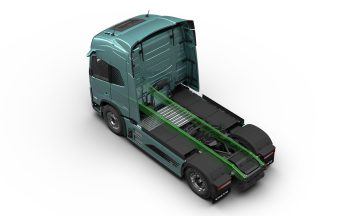Steel makes up 47 percent of a typical diesel-powered truck, the so-called heavy truck, and is responsible for about 44 percent of the CO2 emissions generated during its production. But what if all this steel could be replaced with a low-CO2 emission alternative?
In 2025, Volvo Trucks will begin massively incorporating low-CO2 emission steel into its commercial production. This marks a significant step forward toward its goal of achieving a net-zero emissions supply chain by 2040.
The new low-CO2 emission steel is produced using recycled materials and renewable energy, which reduces emissions by about 80 percent compared to standard steel.
Starting next year, this new lowCO2 steel will be used for rail frames in approximately 12,000 Volvo FH and Volvo FM trucks, which is expected to reduce CO2 emissions by around 6,600 tons. That is equivalent to the annual CO2 emissions produced by 910 European residents.
Why Low-CO2 Emission Steel Is a Key Factor in Producing Net-Zero Emission Trucks
If Volvo Trucks aims to fulfill its environmental ambitions, including a net-zero emissions supply chain, it is crucial to use an alternative to standard steel with low CO2 emissions.
– Since steel is the largest structural material in a truck and its production has the most significant environmental impact, the ability to use a low-CO2 alternative in mass production is genuinely essential for meeting our environmental ambitions, says Håkan Björklund, Product Architect at Volvo Trucks.
IN FOCUS:
- Challenges and Opportunities for Montenegro on the Path to a Circular Economy
- First DC Chargers in Cities Across Serbia
- Naled Advocates For More Efficient Municipal Waste Management in 2025
In 2022, Volvo Trucks became the first truck manufacturer in the world to use fossil-free steel. This steel is produced using a new technology that involves hydrogen instead of coal in the iron reduction process, effectively eliminating all CO2 emissions. However, this technology is still developing and is not yet commercially available in large quantities. In the meantime, Volvo Trucks is exploring ways to use recycled steel to reduce the carbon footprint of its trucks today.
Now that low-CO2 steel is better understood, the next step is to replace steel in different parts of the truck— and that plan is already underway.
How Low-CO2 Emission Steel Could Shape the Future of Truck Transport

Before it could incorporate new lowCO2 steel into production, Volvo Trucks had to test and verify its quality.
– From a technological perspective, we need to understand steel better. Due to its recycled content, there are some differences in its properties. That’s why we had to ensure that it could pass all our internal durability and surface treatment tests and that its characteristics were equal to those of conventional steel. Only then did we decide to start using it in production, explains Harsha A.R., Chief Engineer at Volvo Trucks.
As this is a recently developed product, the available quantities of new steel are still relatively small. However, as the supplier ramps up production for all steel grades, Volvo Trucks hopes to increase its use to replace standard steel consumption.
– Our strategy was to start with one type of steel of a specific thickness in a pilot project, but the plan has always been to expand this practice if the outcome is successful. Now that we have a better understanding of this steel and have tested it, the next step is to apply it to different steel grades and thicknesses and replace steel in various truck sections. That plan is already in preparation, says Harsha.
The successful adoption of lowCO2 emission steel eliminates one of the biggest obstacles to producing net-zero emission heavy trucks. By integrating this innovative material, Volvo Trucks is making a significant step forward in achieving its environmental goals.
Volvo Trucks
The story was published in the Energy portal Magazine CIRCULAR ECONOMY



